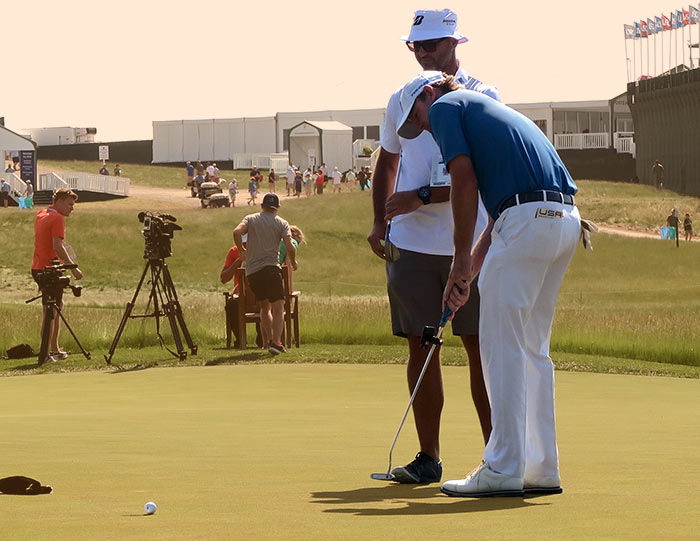We talk through common golf club design myths of drivers, irons, and putters with Ping’s VP of Engineering Paul Wood.
[vc_row][vc_column width=”1/2″ css=”.vc_custom_1489366056001{margin-bottom: -30px !important;}”][vc_btn title=”LISTEN IN ITUNES” align=”center” button_block=”true” link=”url:https%3A%2F%2Fitunes.apple.com%2Fus%2Fpodcast%2Fgolf-science-lab%2Fid1049039619%3Fmt%3D2%26ign-mpt%3Duo%253D4||target:%20_blank|”][/vc_column][vc_column width=”1/2″][vc_btn title=”LISTEN IN GOOGLE PLAY” align=”center” button_block=”true” link=”url:https%3A%2F%2Fplay.google.com%2Fmusic%2Fm%2FIqibmivc622az2cffwftwonz3mm%3Ft%3DGolf_Science_Lab||target:%20_blank|”][/vc_column][/vc_row]
The basic concept of driver engineering explained by Paul in this episode.
Our designers are optimizers. They have a bunch of variables and they have to chose trade offs. For instance, if I could make the center of mass more optimized but I might give up something on the aerodynamics.
A designers job it to take the best of our knowledge and make all those trade offs. For example, turbulators break a trade off because they can stick with a shape that’s great for the moment of inertia, and great for center of mass and now you don’t have to make such a big trade off on aerodynamics.
Here are a few of the questions and tweets we answered:
What makes a driver feel more solid?
Does putter head design effect face rotation??? Ie face balanced putter will help keep the face squared to the path
— Andy Gordon (@Andygordongolf) August 23, 2018
What are the advantages when making non adjustable drivers?
— Andreas Kali (@andreaskaligolf) August 23, 2018
Do aerodynamic features, like the driver that was designed with help from Boeing engineers, really make a big difference or is it mostly marketing?
— Jason Gerdom (@jgerdom) August 23, 2018
Cool… In more generic terms, my question would be about what elements of driver design have the biggest impact on performance and have we reached a point of diminishing returns in some areas, such as aerodynamic design. Are some changes more about marketing something new?
— Jason Gerdom (@jgerdom) August 23, 2018
Along the same lines, we’re finding a large number of moderate speed players fitting into low spin products such as LST and Sub Z due to “across the line” cut patterns. It’s not always a distance strategy to go LST.. dispersion patterns can be aided by that tech as well.
— Greg Gibson (@GGolfpro) August 24, 2018
Learn more from Paul Wood driver design and
Paul Wood – Ping Golf
 Paul is the Vice President of Engineering at Ping, coordinating a department responsible for club design, development, innovation and testing. He moved there in 2005 after completing a PhD studying Solar Flares in the Mathematics Department at St Andrews University, Scotland.
Paul is the Vice President of Engineering at Ping, coordinating a department responsible for club design, development, innovation and testing. He moved there in 2005 after completing a PhD studying Solar Flares in the Mathematics Department at St Andrews University, Scotland.
He has spent most of his time with Ping in the research department working on the physics of ball flight, the club-ball impact and many other aspects of golf science. Some of his projects at Ping include the nFlight fitting software, iPing, Turbulators and TR face technology.
This Episode’s Sponsor
In use by over 30 PGA and LPGA Tour Pros, the GravityFit TPro works as both a tool to help build spinal and shoulder strength and stability… and as a fantastic teaching / swing aid, assisting with arm-body connection, body rotation and timing. Learn more here and use the coupon code CordieWalker
Learn more from Edel Golf here
YEARS OF RESEARCH AND DESIGN IN THE MAKING; THE EDEL SINGLE LENGTH SYSTEM SLS-01 IRONS ARE NOW HERE. SIMPLIFY YOUR GAME.
Traditional logic enforces the notion that variable length irons are correct and that smart people before us deciphered the most accurate way to play the game. Yet, few have questioned the reason why our clubs variate in length.
Ockham’s Razor is a scientific technique or discovery tool to guide researchers and scientists which states Among competing hypotheses, the one with the fewest assumptions should be selected. In golf terms, a set of clubs that allows the player to maintain a single ball position, swing plane, and rhythm rate would provide the logical explanation to achieve optimal performance.
All with a club that has singularity of length, weight, bounce, shaft weight, and shaft flex to optimize the simplicity of repeating your ideal swing.
SIMPLIFY YOUR GAME. SINGLE LENGTH. SINGLE SWING.




